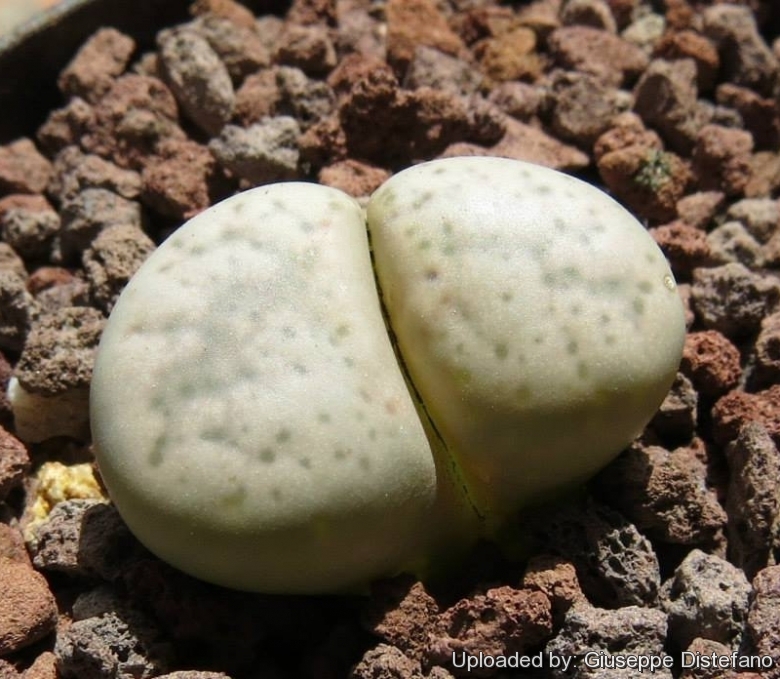Accepted Scientific Name: Lithops francisci (Dinter & Schwantes) N.E.Br.
Gard. Chron. 1926, Ser. III. lxxix. 102. [6 Feb. 1926] ( non "franciscii", "francisii" )

Mesembryanthemum francisci (Lithops francisci) Photo by: Giuseppe Distefano
Origin and Habitat: It is found in a restricted range and small population in the Lüderitz district, Namibia.
Habitat: Its natural habitats are rocky areas and cold desert. The stones comprises: gneiss and schist. The colour of the background varies from light grey-white to light brown, with some black.
Synonyms:
See all synonyms of Lithops francisci
back
Accepted name in llifle Database:Lithops francisci (Dinter & Schwantes) N.E.Br.Gard. Chron. 1926, Ser. III. lxxix. 102. [6 Feb. 1926] ( non "franciscii", "francisii" )Synonymy: 4
back
Common Names include:
ENGLISH: Living Stone, Stone Plant
ITALIAN (Italiano): Pianta sasso
Description: Lithops franciscii is generally smaller than most Lithops and (especially in cultivation) tends to grow not buried in the ground and often shows an elongated shape rather than the classical underground cordate (heart-shaped) form. It is easily recognizable for the very numerous dull grey-green dots on an opaque beige, grey-white or cream body often with yellow, green or pink nuances. It can form quite large groups with up to 20 or more heads, but usually it as only 3 to 6 heads. This species grows quickly from seed and flower easily.
Bodies (paired leaves): Usually distinctly convex, sometimes truncated; bifurcate with a deep fissure (about 6-12 mm); the lobes lobes are conjunct to slightly divergent. Face: The top face is opaque, smooth to rugose, slightly elevated, with almost always unequal lobes. This species usually do not shows clearly evident margins or shows very irregular margins, with fragmented peninsulas. The windows are usually occluded or absent giving the surface its typical opaque aspect. The surface shows narrow, indistinct and slightly impressed dull grey-green channels and also a network of nebulous, very irregular and fragmented island, but the top of the leaves are scattered by numerous dots ( dusky dots) that are transparent round, small, up to 0,5 mm in Ø, very slightly impressed. The patterns of colour of the dots on the face is more or less regular within certain ranges of similarity over the whole face, but often they are concentrated in and along the border of the channels, it is also arduous to tell apart between concentrations of dots and channels. For this species, the dusky dots are very specific ranging in colour from dull grey through dull green.
Flowers: Yellow, small sized up to 25 mm in diameter, but usually less.
Fruits: 5 loculed capsules.
Seeds: Yellowish brown, rugose.
Subspecies, varieties, forms and cultivars of plants belonging to the Lithops francisci group
Bibliography: Major refences and further lectures
1) Heidrun E. K. Hartmann “Aizoaceae F – Z” Springer 2002
2) Achim Hecktheuer “Mesembs, mehr als nur Lithops” Books on Demand GmbH Norderstedt. 2008
3) Desmond T. Cole & Naureen A. Cole, Uwe Beyer, Yves Delange “Les Lithops” SUCCULENTES Spécial 2008 AIAPS (now Terra seca). 2008
4) Desmond T. Cole & Naureen A. Cole “LITHOPS Flowering Stones” Cactus & Co. Libri. 2005
5) Yasuhiko Shimada “The Genus Lithops” Dobun Shoin. 2001
6) Rudolf Heine “Lithops - Lebende Steine” Neumann Verlag. 1986
7) Bernd Schlösser “Lithops – Lebende Steine” Praktische Anleitung für die Zimmerkultur. Bussiness Point MEDIA. 2000
8) Steven A. Hammer “Lithops – Treasures of the veld” British Cactus and Succulent Society. 1999
9) Desmond T. Cole “Lithops – Flowering Stones” Acorn Books CC. 1988
10) Rudolf Heine “Lithops – lebende Steine” Neumann Verlag. 1986
11) David L. Sprechman “Lithops” Associated University Presses, Inc. 1970
12) Gert Cornelius Nel “Lithops” Hortors Limited, South Africa 1946
Cultivation and Propagation: Lithops francisciSN|13559]]SN|13559]] need an open mineral, fast draining mix and the maximum amount of light you are able to give them. The basic cultivation routine is: Stop watering after flowering. Start watering after the old leaves completely dry. (Usually late March or Early April) Water freely during the growing season, soak the compost fully but allow it to dry out between waterings, no water when cold. Some growers fertilize frequently, some hardly ever. Keep them dry during the winter. Nearly all problems occur as a result of overwatering and poor ventilation especially when weather conditions are dull and cool or very humid. This plant is best for a well lit area (Bright shade to full sun).
Remarks: After flowering in the autumn and extending through winter season the plant doesn’t need watering, but they will still be growing, the new bodies will be increasing in size extracting water from the outer succulent leaves, allowing them to shrivel away. In fact the plant in this time extracts water and nutrient stored in the outer succulent leaves, allowing them to dehydrate relocating the water to the rest of the plant and to the new leaves that form during this period until the old leaves are reduced to nothing more than "thin papery shells".











